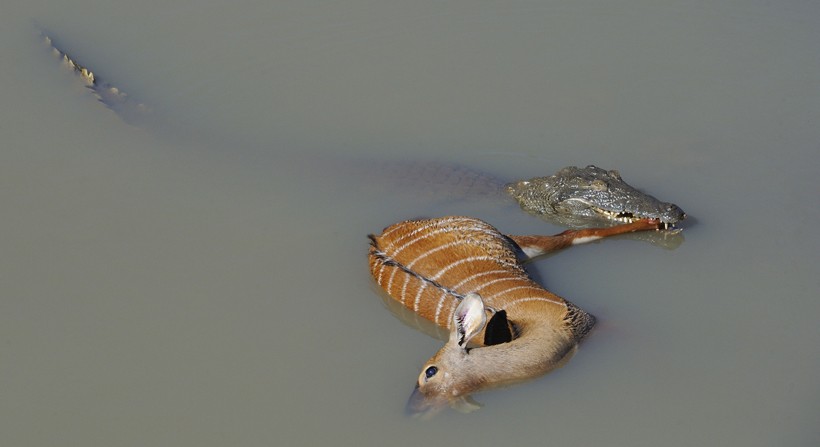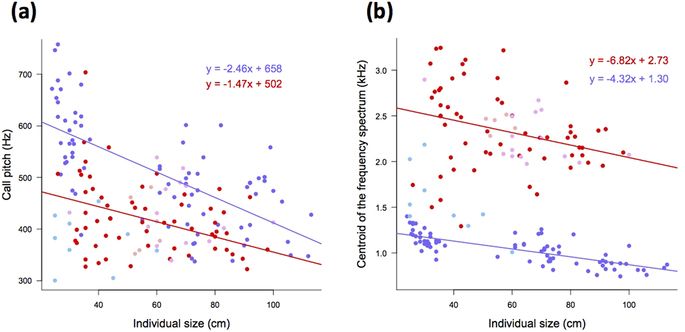Post by Vodmeister on Mar 1, 2014 1:42:03 GMT 5

Local names
Mamba, Garwe, Ngwenya
Conservation Status
Lower Risk, least concerned (LR/lc)
Currently there are an estimated 250,000 to 500,000 Nile crocodiles alive in the wild; 4,000 in the Kruger National Park, about 800 in the Greater St. Lucia Wetland Park and 2,000-3,000 in the Ndumu Wildlife Conservation Area.
Scientific classification
Kingdom: Animalia
Phylum: Chordata
Subphylum: Vertebrata
Class: Sauropsida
Order: Reptilia
Family: Crocodylidae
Subfamily: Crocodylinae
Genus: Crocodylus
Species: C.niloticus
Crocodilians are archosaurs, early forms splitting off from the other reptiles during the Triassic about 200 million years BP. Like birds, crocodilians have gizzards and a 4-chambered heart, not the 3-chambered heart of other reptiles. Crocodilians consist of three families and 23 species
Successful, sustainable programs focusing on ranching crocodiles for their skins have been successfully implemented throughout Africa. In 1993 80,000 Nile crocodile skins were commercially produced, the majority from ranches in Zimbabwe and South Africa. In central and west Africa, which makes up about two-thirds of the Nile crocodile's habitat, the situation is grimmer. The population in this area is much more sparse and is in competition with the sympatric African slender-snouted crocodile and the African dwarf crocodile.
Description
All crocodilians have short walking legs, a powerful tail and incredibly powerful jaws with 64-68 razor-sharp, conical teeth. The teeth are replaced about 45 times during a life span. The tongue is not split as in most reptiles and contains excretion glands for the disposal of excess salt from the body that allows the crocodile to inhabit both fresh and saline water.
Crocodilians have a palatal valve on the back of the tongue that closes against the upper jaw, sealing the throat while underwater. Eyesight is excellent both during day and at night. The eyes lie laterally on top of the head and protrude above the water when the animal surfaces. They posses clear nictitating membranes or third eyelids that protect the eye when swimming or hunting and increases underwater vision. Crocodiles also possess ossified scales on the back and tail called osteoderms that form a protective armour. With the webbed hind feet and tail they can swim at 30-35 km/hr. They can walk on land and gallop for short distances at speeds ranging up to 14 km/hr.
Nile crocodiles are known to reach a greater size in the hot Afro-tropics; individuals >5 m and >750 kg are sporadically reported from Lake Nasser in Egypt. They are smaller in cooler sub-tropical regions such as southern Africa, average length for adult males 4.2 m. The largest living specimen, a notorious man-eater from Burundi, was believed to be between 6.2-7.5 m.
The largest known Nile crocodile from South Africa was captured alive by J.G. Kulmann in the Mutale River near Lake Funduzi in Venda. It had a total body length of 5.499 m (18 feet 1/2”) and a mass of 905.7 kg. In Africa, a specimen collected in the Simliki River in Uganda in 1953 measured 5.94 m (19 feet 57/8”) and weighed 600 kg and another in the Okavango swamps in Botswana in 1968 measured 5.87 m (19 feet 31/8”) with a mass of 600 kg.

Characteristic Morphometrics of both sexes
Adult body weight(kg)
400-500 (max. 900)[M] 150-300 (max. 600) [F]
Hatchling body weight(g)
100-110 [both sexes]
Adult body length (m)
4.0-5.5 (max. 6.1)[M] 3.0-4.0 (max. 5.0)[F]
Hatchling body length(cm)
25-30[both sexes]
Age of maturity(years)
10-12 (at 3 m body length) [M}& 10-12 (at 2-2.25 m body length) [F]
Distribution & Habitat requirement
The crocodile is largely restricted to living in tropical and sub-tropical environments such as the Afro-tropics of Central Africa. They prefer warmer water of 22-30°C. They live in lakes, rivers, freshwater swamps and brackish water, in deep pools and on sand banks with suitable nesting spots and a sufficient food supply. Surface water is essential. If it evaporates a crocodile will either migrate in search of another source or will aestivate. Fast flowing water and streams are generally avoided. Slightly murky water is preferred over clear water.
Behavior
Crocodiles are cold-blooded and do not have constant body temperature. The core body temperature is built up to a maximum of 38°C by basking in the sun during daylight hours. The energy generated is used for digesting food, hunting and social behaviour. Without sufficient core temperature, a crocodile cannot digest food and in an extended period of cold may become poisoned by the undigested, rotten food matter in its stomach. After sunset the core body temperature drops rapidly to a minimum of 15°C. During drought periods, a crocodile may enter a hibernation which can last for several months. They dig a den in a dry riverbed or riverbank and retreat into it and can survive without feeding for up to two years. They also migrate several kilometres across dry land in search of alternative resources.
Feeding & Nutrition
The diet of this mono-gastric, carnivorous predator changes markedly with age. Juveniles feed on insects, spiders, snails, gastropods and mussels. Young crocodiles feed mostly on toads, frogs and small fish such as Clarias, Labeo and Tilapia spp., while sub-adults feed increasingly on reptiles such as terrapins, pythons, snakes, water-birds, crabs, and rodents. With age the diet changes to barbel (catfish) and larger mammals up to the size of young giraffe, buffalo and elephant. On average barbel comprises 70% of the diet of adults. They are known to prey on plains zebra, Cape buffalo, warthog, hyaena, baboon, blue wildebeest, impala, giraffe, big cats (especially lion) and other crocodiles. When taking prey on the waters edge an adult crocodile raises the fore quarters of its body to a height of 1.2 m above the water surface and simultaneously throws its entire body forward in a charge of 10-20 m onto dry land.
Weekly food consumption (adults)
- ~5-8kg [M]
- ~4-5kg [F]

Groups of Nile crocodiles sharing a kill use each other for leverage in order to perform death rolls. The head must be lifted above surface in order to consume prey as crocodiles cannot swallow underwater. Carrion is taken only when fresh food is not available. The powerful enzymatic digestive juices of crocodiles completely digest bones, hooves and feathers but being poikilothermic animals, digestion is promoted by higher temperatures. In warm water of >22-30°C crocodiles remain submerged for approximately 15 min, but in cool water of 14-20°C up to 60 min and in cold water of<12°C for up to two hours.
Social structure & reproductive characteristics
Crocodiles are gregarious animals. Groups are known as “floats” when in the water or “basks” when on land. Group size depends on food abundance and may range from two to >100 individuals. When food resources are depleted or when the surface water dries up, groups tend to break up and individuals may become temporarily solitary. Individuals in groups continuously communicate with a variety of pitched vocals. Body contact is tolerated and they often lie against or over each other.
In the wild, both sexes reach sexual maturity at an age of 10-12 years. The onset in males occurs at a length of about 2.8-3 m with an approximate mass of 200 kg and in females at a length of 2-2.5 and a mass of 150 kg. Females start mating on reaching sexual maturity. However, males only begin mating at an age of 15 years when they are 3.5-4 m long and have a mass of 400 kg. Crocodiles are divided into hole-nesters and mound-nesters, with the Nile crocodile being a hole-nester. The preferred nesting locations are sandy shores, dry stream beds and riverbanks. The female digs a hole 40-50 cm deep a few meters from the bank and lays 25-90 eggs. The mother covers the eggs with a layer of sand and guards them for the three month incubation period. The mother protects her offspring for about 10 days. Mothers may form a crèche if there are multiple nests in the area. After two years the juveniles are close to 1.2 m long and leave the nest area, avoiding the territories of older and larger crocodiles. Only 2% of the hatchlings survive to live beyond a size of 1.5 m length but after this time the mortality rate drops radically as the adult crocodile has few enemies besides humans.

Clutch characteristics
- Number of eggs per clutch number: 25-90 (avg. 45)
- Incubation period: 90 days
- Hatchling season: Dec-Mar
- Egg-laying season: Sep-Dec
- Hatchling dispersal age: months 3
- Independent at ~2 years of age( or at 1.2m TBL)
- Gender ratio: 1:1.5
- Annual population growth: ~2%
- Mating season: May-Aug
- Alderton, D. 1991. Crocodiles and Alligators of the World. Facts on File, New York.
- Blake, DK, 2006. The Nile crocodile In: Intensive wildlife production in southern Africa, Eds. J du P Bothma and N van Rooyen, Van Schaik Publishers, Pretoria.Crocodile Specialist Group, 1996. Crocodiles. IUCN, Gland, Zwitzerland.
- Grnard, S. 1991. Handbook of Alligators and Crocodiles. Florida: Kreger Publishing Company.
- Leslie, AJ, 1997. The ecology and physiology of the Nile crocodile in Lake St Lucia, KwaZulu-Natal, S.A. Ph.D thesis Philadelphia, Drexel University.
- Levy, C. 1991. Crocodiles and Alligators. London: Quintet Publishing Limited.
- Pooley, AC, 1982. The status of African crocodiles in 1980. In: Crocodiles. Proceedings of the 5th Working Meeting of the IUCN/SSC Crocodile Specialist Group, Gainesville, Florida. IUCN, Gland, Switzerland. pp. 174-228
- Steel, R, 1989. Crocodiles. London, Christopher Helm.
- Thorbjarnarson, J. 1992. Crocodiles-An Action Plan for Their Conservation. IUNC, Gland, Switzerland.
- Webb, JW, Grahame, MS. Whitehead and Peter. J, 1987. Wildlife Management: Crocodiles and Alligators. Surrey Beatty and Sons Pty Limited, Australia.
- Wikipedia, 2008. Crocodillians, en.wikipedia.org/wiki/Nile_crocodile
- www.wildliferanching.com/content/nile-crocodile-crocodylus-niloticus



















 [/small]
[/small]

